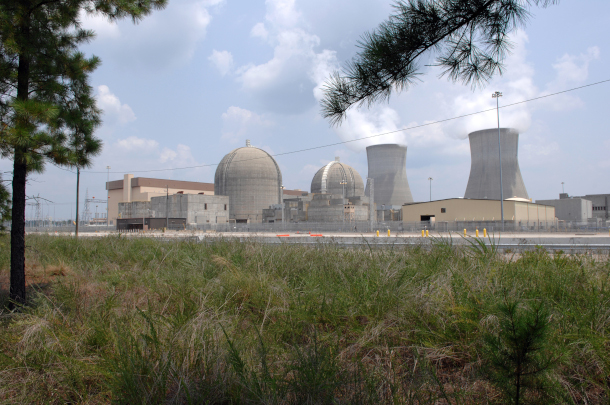Beyond the Headlines
Air Date: Week of April 29, 2022

President Biden’s executive order will create the first-ever inventory of old-growth forests on federal lands. (Photo: Dan Myers on Unsplash)
On this week's trip beyond the headlines, Host Jenni Doering chats with Environmental Health News' Weekend Editor Peter Dykstra about two moves from the Biden Administration: one, to inventory and protect old growth forests, and two, a $6 billion bailout for nuclear power plants. And then, from the history books, the two take a look at the Chernobyl nuclear disaster in 1986.
Transcript
DOERING: It's time to take a look beyond the headlines with Peter Dykstra. Peter's an editor with Environmental Health News. That's EHN.org and DailyClimate.org. And he's on the line from Atlanta, Georgia. Hello, and a belated Happy Earth Day, Peter.
DYKSTRA: Happy Earth Day to you too, Jenni. We're going to start with an item from Earth Day last week when President Biden traveled to Washington State to announce an initiative to protect old growth forests. Something completely surprised me is that the United States has never taken an inventory of how much old growth forest exists on federally owned and managed lands.
DOERING: Really? That's so surprising, because we know that these are such important carbon sinks, Peter.
DYKSTRA: They are and they're just important from a symbolic standpoint that you don't want to cut old growth back. They tend to harbor some endangered species like the northern spotted owl, which was a big endangered species controversy a few decades ago. Biden signed an executive order that not only created this first ever inventory of old growth forests on federal lands, but it's also going to do a better job of looking after old growth in the face of increased wildfires. Something else that I didn't know is that wildfires in California over the last couple of years claimed what is estimated to be 10% of the entire world's biggest trees, those giant sequoia Redwoods in California.
DOERING: That's just shocking. I mean, when you think about those trees, many of them have been growing for the last 2000 years. You know, if you lose 10%, every few years, they'll be gone soon.
DYKSTRA: You kill off the old forests, you kill off other animals as well.
DOERING: Well, hopefully, at least inventorying what we have left will help protect these ancient trees. What else do you have for us this week, Peter?
DYKSTRA: I'm gonna go nuclear on you, Jenni. There's another thing announced by the Biden administration, maybe not quite so welcomed by many conservationists. The Energy Department has launched a $6 billion nuclear plant bailout effort. Now what this would do is help utilities that because of economics are closing down nuclear plants early, they hope to extend the life of nuclear plants, reasoning that nuclear is carbon free. And this would help combat climate change. Distressed owners and operators of nuclear plants, they're going to apply for grants to prevent those plants from closing too early.

Units 3 and 4 of the Vogtle Electric Generating Plant in Waynesboro, Georgia have been under construction since 2013. (Photo: Southern Nuclear, Nuclear Regulatory Commission, Flickr, CC BY-NC-ND 2.0)
DOERING: With a bailout that big, Peter, I guess that must mean that these plants are really in hot water economically.
DYKSTRA: No pun intended, economically or any other way.
DOERING: Well, what do you have for us in the history books this week, Peter?

The ruins of Chernobyl’s #4 reactor, which was destroyed in April of 1986. (Photo: Ukranian Society for Friendship and Cultural Relations with Foreign Countries, IAEA Imagebank, Wikimedia Commons, CC BY-SA 2.0)
DYKSTRA: I have more nukes, and this one also pertains to the Russian invasion of Ukraine. Because on April 25, 1986, there was an explosion at the Chernobyl Nuclear Power Complex, north of the Ukrainian capital Kyiv, in what was then part of the Soviet Union. A reactor core partially melted. Radiation was released in astoundingly high levels, later detected as much as 1000 miles away in Scandinavia. The Soviets relocated 350,000 people. There's a huge exclusion zone around the contaminated plant. Nobody can agree on how many people were affected by the radiation. And of course, Chernobyl is back in the news these days, because when the Russians came into Ukraine, one of the first things they did is to occupy the Chernobyl site, ostensibly to keep their hands on radioactive materials. But they may have done that literally because they were said to be digging and mucking around in areas known to be contaminated, adding to the risk to those Russian soldiers that were part of the invasion. Russia pulled out of the Chernobyl exclusion zone in a matter of weeks and left it to the Ukrainians to deal with.
DOERING: Right, I mean, one has to wonder if they really understood the risk that they were getting into with digging into this contaminated, radioactive soil.
DYKSTRA: Or given the way the rest of the war has been pursued, not necessarily whether they knew, but whether they cared.
DOERING: Well, thank you, Peter. Peter Dykstra is an editor with Environmental Health News. That's EHN.org and DailyClimate.org. And we'll talk to you again next week, Peter.
DYKSTRA: Okay, bye bye Jenni.
DOERING: And there's more on these stories at the Living on Earth website. That's LOE.org.
Links
Reuters | “Biden Unveils Plans to Rescue Giant Trees as Part of Earth Day”
The Washington Post | “Biden Administration Launches $6 Billion Nuclear Plant Bailout”
Living on Earth wants to hear from you!
Living on Earth
62 Calef Highway, Suite 212
Lee, NH 03861
Telephone: 617-287-4121
E-mail: comments@loe.org
Newsletter [Click here]
Donate to Living on Earth!
Living on Earth is an independent media program and relies entirely on contributions from listeners and institutions supporting public service. Please donate now to preserve an independent environmental voice.
NewsletterLiving on Earth offers a weekly delivery of the show's rundown to your mailbox. Sign up for our newsletter today!
 Sailors For The Sea: Be the change you want to sea.
Sailors For The Sea: Be the change you want to sea.
 The Grantham Foundation for the Protection of the Environment: Committed to protecting and improving the health of the global environment.
The Grantham Foundation for the Protection of the Environment: Committed to protecting and improving the health of the global environment.
 Contribute to Living on Earth and receive, as our gift to you, an archival print of one of Mark Seth Lender's extraordinary wildlife photographs. Follow the link to see Mark's current collection of photographs.
Contribute to Living on Earth and receive, as our gift to you, an archival print of one of Mark Seth Lender's extraordinary wildlife photographs. Follow the link to see Mark's current collection of photographs.
 Buy a signed copy of Mark Seth Lender's book Smeagull the Seagull & support Living on Earth
Buy a signed copy of Mark Seth Lender's book Smeagull the Seagull & support Living on Earth

